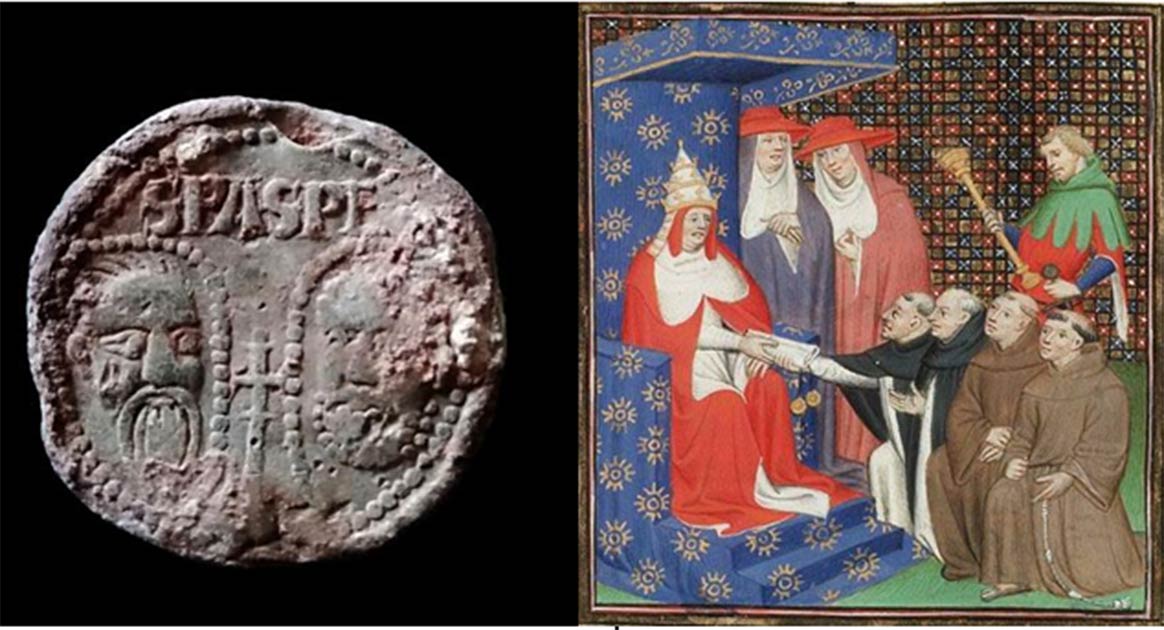Warrior Pope’s Seal is 1.5 Millionth Archaeological Find in Britain!
A metal detectorist has unearthed the 1.5 millionth archaeological artifact to be found by the public in Britain under a government-backed scheme. This item is one of great historic interest. It is a pope’s seal that belonged to a powerful medieval religious leader who played an important role in the history of Italy.
‘The object is the 1.5 millionth to be discovered in the British Museum's Portable Antiquities Scheme (PAS),’ according to the Daily Mail. This scheme was established in 1997 so that any items unearthed by the public can be recorded and preserved. In the 23 years since it was established, the scheme has yielded many treasures such as the Staffordshire Hoard, an Anglo-Saxon treasure, and the Chew Valley Hoard, a cache of ancient coins. The PAS scheme has, according to historical researchers, transformed “what 'is known about life through time on the British Isles.”

Staffordshire hoard was the large hoard of Anglo-Saxon gold discovered in 2009 near Lichfield in England. (CC BY 2.0)
Buried Treasure
In Britain, any find that may be of historical importance must be registered under the scheme. The discovery of the 1.5 millionth object under the PAS scheme is a testament to its success. Many of these objects have been unearthed by metal detectorists, which is now a popular pastime in Britain and elsewhere.
If the objects are of potential archaeological value, they need to be reported to the local coroner under a law from 1996. Failure to do this can result in a hefty fine or time in prison. However, the coroner can determine the value of an unearthed item and the sum can be shared between the finder and the property owner of the land where an artifact was located.

The Papal bulla (Pope’s seal) held by the man who found it. (Andy Bassett)
The Pope’s Seal was Found on Farmland
The historic find was made by Andy Bassett, a metal detectorist. He unearthed the object in a tilled field on a farm in the English county of Shropshire. Mr. Basset had the object registered with PAS, not knowing that it was the 1.5 millionth item to be uncovered under the scheme. It is believed that the historic find was made before the lockdown in Britain in March.
Sign of a Medieval Warrior Pope
Mr. Basset was surprised when he unearthed a coin-shaped object. However, it was soon revealed that the object was not money but a seal. The item belonged to Pope Innocent IV and he would use it ‘to confer political and religious favours,’ reports the Evening Standard.
The seal is stamped with symbols and phrases that are in Latin. These allowed researchers to authenticate the seal and to date it.
Pope Innocent IV (c. 1195 – 1254), whose real name was Sinibaldo Fieschi, became Pope in 1243. He was head of the Catholic Church and was not just an important religious figure but also an immensely powerful secular ruler. He engaged in a vicious struggle with the Holy Roman Emperor, Frederick II, over control of Italy. He was forced into exile briefly because of this conflict with the German Emperor. Innocent IV died while on campaign with the Papal army in Italy.

Saint Clare of Assisi Blessing the Bread before Pope Innocent IV. (Public Domain)
The Mystery of the Pope’s Seal
Peter Reavill of the British Museum, who works as a PAS liaison officer in Shropshire, stated that “the seal may have ended up in the English countryside because the Pope was trying to obtain Henry III’s support in his claim for Sicily.” It would have been affixed to a letter sent by the Pope and it may simply have fallen off and been lost. Mr. Reavill also states that the Pope’s seal “may have been given as an ““indulgence” to a rich, powerful individual who gave money to the church in exchange for ‘so many years out of purgatory.” Popes often used such indulgences to win political support or even to secure financial donations.
- What Really Lies Hidden in the Vatican Secret Archives?
- Bones of the First Pope Found in a London Rubbish Bin? It would have to be a Miracle
- The Origin of the Knights Templar – Descendants of Jewish Elders?

Lead papal bulla of Pope Innocent IV (1243-54). (CC BY SA 2.0) One face bears the conventional stamped busts of Saints Peter and Paul both within drop-shaped pelleted borders, possibly haloes. On the reverse are the words INNOCENTIVS PP IIII. The PP stands for Pastor Pastorum, meaning shepherd of the shepherds.
The Pope’s seal may have been kept as a souvenir or as a talisman. This seal does not have a huge financial value and the finder and the owner of the land where it was found will not receive a financial windfall.
However, it is important from a historical perspective. Reavill told The Shropshire Star that “the archaeology of the region is definitely richer for its find.” It is hoped that many more finds will be made under the scheme and they will greatly add to the heritage of Britain.
Top image: The Pope’s seal found in Shropshire, England, (British Museum’s Portable Antiquities Scheme) belonged to Pope Innocent IV. (Public Domain)
By Ed Whelan



















